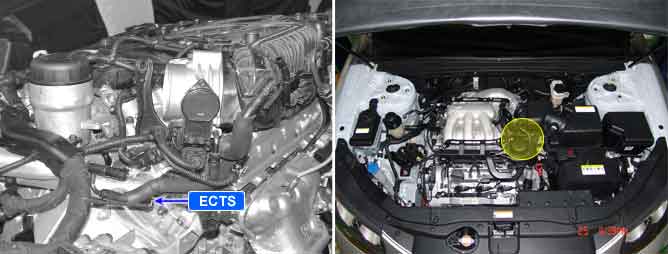

The Engine Coolant Temperature Sensor (ECTS) is located in the engine coolant passage of the cylinder head for detecting the engine coolant temperature. The ECTS uses a thermistor whose resistance changes with the temperature. The electrical resistance of the ECTS decreases as the temperature increases, and increases as the temperature decreases. The reference 5 V in the PCM is supplied to the ECTS via a resistor in the PCM. That is, the resistor in the PCM and the thermistor in the ECTS are connected in series. When the resistance value of the thermistor in the ECTS changes according to the engine coolant temperature, the output voltage also changes. During cold engine operation the PCM increases the fuel injection duration and controls the ignition timing using the information of engine coolant temperature to avoid engine stalling and improve drivability.
Checking the engine coolant temperature under detecting condition, if the engine coolant temperature’s signal is temporarily stuck above the lowest enable temperature to enable other diagnostic, PCM sets P0116.
Item | Detecting Condition | Possible cause |
DTC Strategy | ● Monitor the engine coolant temperature | ● ECTS |
Enable Conditions | ● Shutdown time > 180 minutes ● Intake air-temperature at start-up < 40℃(104℉) ● No disabling faults(ECTS) ● Engine running > 60 seconds ● Minimum airflow is satisfied for a certain time. | |
Threshold Value | ● When the start-up engine coolant temperature does not rise by 3 ℃(5.4℉). | |
Diagnosis Time | ● Immediately | |
MIL On Condition | ● No MIL ON (DTC only) |
Temp. (°C/°F) | Resistance (kΩ) | Temp. (°C/°F) | Resistance (kΩ) |
-40(-40) | 48.14 | 40(104) | 1.15 |
-20(-4) | 14.13 ~ 16.83 | 60(140) | 0.59 |
0(32) | 5.79 | 80(176) | 0.32 |
20(68) | 2.31 ~ 2.59 |

Fig1) Service data before startup

Fig2) Service data in a few minutes since startup
The output signals of IATS & ECTS change smoothly without any rapid changes. Those have almost same characteristic signal during the early period after start. It means that the temperatures of intake air and engine coolant are depended on the temperature of atmosphere. Meanwhile, during the warming up, the output signal of ECTS is going up increasingly. but, the output signal of IATS changes a little bit. even it may not change almost. It means that the heat of engine does not affect on the temperature of intake air.